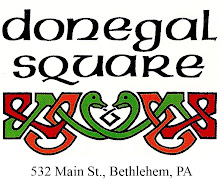"May the roof above us never fall in, and may we friends gathered below never fall out."
-Irish Toast
Dear Angus,
I have been admiring the plentitudes of available drinking establishments during my stay in Ireland as often as possible, and I was wondering if you could enlighten me on the history of pubs in the British Isles? If anyone, you should know! Thanks.
-SOON TO BE ENLIGHTEND DRUNK
Dear Enlightend Drunk,
Och, aye, ye canna be drinking in our fine establishments without knowin’ a bit o’history behind ‘em. To help ye in yer quest fer knowledge I ha written a wee essay on the matter:
A Short, Random History of Pubs in General
The people of the British Isles ha been drinkin’ ale since the Bronze Age, but it wasn’t till the arrival of the Romans and their establishment of the Roman road network that the first inns, precursors to the pubs, began to appear. By the time the Romans took off, visiting the pub had a course become a part of the working man’s routine. They became so popular that in 965 the sassenach English King Edgar decreed that there should be no more than one alehouse per village, imagine that!
Tha word “pub” is short for “public house,” which is the opposite of “private house,” where only tha members could go in for a pint. Using pictures on signs to identify the pubs became necessary, because many of the early patrons were the illiterate, hard-working members of the lower classes. Pubs often ha’ traditional names, but others seem nonsensical. These strange names may be corruptions of older names or phrases; fer example, “The Oyster Reach” pub in Ipswich, England spent several decades being called the “Ostrich,” before historians let the owners know of the original name.
In 1215, the measure for ale was standardized in the Magna Carta. By 1625, there were over thirteen thousand inns and taverns around the United Kingdom for a population of just five million. As the number of public houses grew, so did the number of breweries; by 1800, there were twenty-four thousand, a number that, of course, has fallen considerably. Today, there are just three large breweries in England, with about three hundred independent regional breweries, all operating in a highly competitive market.
Perhaps the best-known pubs are those of Ireland. The Irish pub is the greatest symbol of Irish social life, and the Irish pub experience has been reproduced, with varying success, all over the world. Irish pubs are much more than places to have a quick drink. They have a culture all their own, and in Ireland, a pub can easily be found in every town, village and city. They are the heart of Ireland’s social life, and perhaps the ultimate setting for human interaction.
Perhaps the greatest attraction of Irish pubs, besides the availability of alcoholic beverages, is that they provide a place for the craic (pronounced ‘crack,’ and no, it is not the highly addictive illegal drug). What is the craic? Craic is friends, laughter, good times, dancing, music and an unmistakably Irish atmosphere. Put it all together, with just the right amount of each, and ye’ll have some idea of what the craic is. The ideal setting to find the craic is in an Irish pub. But the craic doesn’t have to be restricted to Ireland. It can be found everywhere if the ingredients are right, as I’m sure ye have already found out.
-ANGUS
Subscribe to:
Post Comments (Atom)


No comments:
Post a Comment